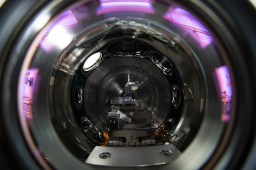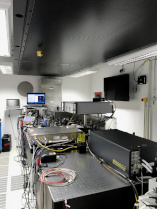Dielectric Laser Accelerators

Image: DLA Chamber inside
Dielectric laser accelerators (DLAs) at optical frequencies are electron accelerators miniaturized to the chip level. This miniaturization opens up new and hopefully more applications of electron sources in science and technology at significantly reduced costs. The DLA concept relies on the interaction of electrons with an intense laser field inside a nanometer scale dielectric photonic structure fabricated by modern semiconductor manufacturing technology.
DLAs on CHIP are fully optically driven at repetition rates ranging from kHz to GHz range, allowing high-current with low-charge per pulse. Since they are inherently synchronized with ultrafast lasers, they are ideal tools for bringing the versatility of the world of integrated photonics to the realm of electrons.
The DLA project, led by Huseyin Cankaya, is focused on driving a DLA into the relativistic regime with ultrafast laser pulses in the mid-infrared spectral region. In order to achieve acceleration to the relativistic regime, electrons are accelerated by a conventional RF-accelerator (ARES LINAC) to about 100 MeV before being injected into a DLA on CHIP, where further acceleration by a mid-infrared laser field occurs. Tight synchronization between the electron bunches and the mid-infrared laser field within a fraction of the wavelength is essential to successfully execute the experiment. In these first acceleration experiments, an energy gain in the range of 1 MeV is expected.

Image: Sinbad Laser
The versatile DLA team is also developing novel ultrafast laser sources in the mid-infrared wavelength region as the drivers for the DLAs in close collaboration with Solid-state lasers team.
These combined efforts are possible through the close collaboration of the UFOX Group with the DESY Accelerator Research & Development Group led by Ralf Assmann and the DESY Laser Science & Technology Group led by Ingmar Hartl.
The DLA team is also participating in The Accelerator on a CHIP (ACHIP) International Program, led by University of Erlangen and Stanford University and funded by Gordon and Betty Moore Foundation. Together with the DESY Accelerator Research & Development Group and the DESY Laser Science & Technology Group, we are contributing to the ACHIP program with our expertise in ultrafast laser technology and unique electron source capabilities.
Relevant References:
[1] Niedermayer, et al., Challenges in simulating beam dynamics of dielectric laser acceleration. (2019)
[2] Mayet, et al., Simulations and plans for possible DLA experiments at SINBAD. (2018)
[3] Murari, et al., Intracavity gain shaping in millijoule-level. (2016)
[4] Murari, et al., Kagome-fiber-based pulse compression of mid-infrared picosecond pulses from a Ho:YLF amplifier. (2016)
[5] Kroetz, et al., Numerical study of spectral shaping in high energy Ho:YLF amplifiers. (2016)
[6] Kroetz, et al., Overcoming bifurcation instability in high-repetition-rate Ho:YLF regenerative amplifiers. (2015)